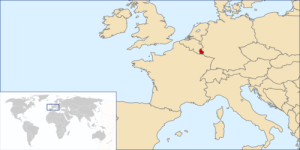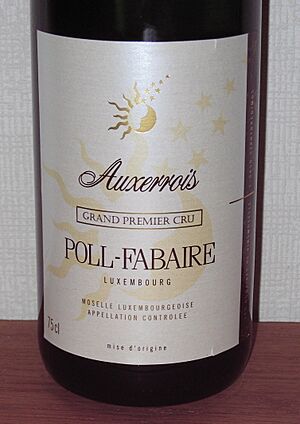Cuisine of Luxembourg facts for kids
Luxembourg's food is a mix of different cultures! Because Luxembourg is located between France, Belgium, and Germany, its cooking styles are influenced by these neighbors. Recently, many people from Italy and Portugal have moved to Luxembourg, adding their own delicious flavors to the local dishes.
Just like in Germany, many traditional everyday meals in Luxembourg come from simple, old recipes. These are different from the fancy dishes you might find in French cooking.
Contents
Luxembourg's Yummy Food
Luxembourg has many special foods to try! Besides French pastries, cakes, and fruit pies, you can find local treats.
Sweet Treats
Some sweet specialties include:
- Bretzel: A pretzel, which is a special treat during the time of Lent.
- Quetscheflued: A delicious tart made with plums.
- Verwurelt Gedanken or Verwurelter: These are small, sugar-coated doughnuts.
- Äppelklatzen: Apples baked inside a pastry crust.
Luxembourg also has a special cheese called Kachkéis or Cancoillotte. It's a soft cheese spread.
River Delights
Fish from local rivers like trout, pike, and crayfish are used in many dishes.
- F'rell am Rèisleck: Trout cooked in a tasty Riesling wine sauce.
- Hiecht mat Kraiderzooss: Pike served with a green herb sauce.
- Kriibsen: Crayfish, often prepared in a Riesling sauce.
Another popular dish is Fritür or Friture de la Moselle. This is made with small fried fish from the Moselle River. People often enjoy it with a local white wine from the Moselle region.
Hearty Meat Dishes
Meat dishes are very popular in Luxembourg.
- Éisleker Ham: This is ham from the Oesling region in the north of the country. It's soaked for a few weeks, then smoked for several days. It's usually served in thin slices with chipped potatoes and a salad.
- Judd mat Gaardebounen: This is perhaps the most traditional meat dish in Luxembourg. It's smoked collar of pork with broad beans. The pork is soaked overnight, then boiled with vegetables and spices. It's served in big slices with the beans and boiled potatoes. Many people consider it the national dish of Luxembourg.
- Hong am Rèisleck: This dish is similar to the French Coq au Riesling. It has browned chicken pieces cooked slowly in white wine with vegetables, spices, and mushrooms.
- Huesenziwwi or Civet de lièvre: This is a jugged hare dish. It's usually served during the hunting season.
Other Tasty Bites
Other dishes you might find include:
- Liver dumplings (quenelle) served with sauerkraut and boiled potatoes.
- Träipen: This is a type of black pudding, often served with apple sauce.
- Sausages with mashed potatoes and horseradish.
- Green bean soup (Bouneschlupp).
You'll also find many French dishes on menus, along with some popular foods from Germany and Belgium.
More Delicious Specialties
Here are some other special foods from Luxembourg:
- Thüringer: These sausages taste like a spicy version of the German bratwurst. Today, they are officially called Lëtzebuerger Grillwurscht, or Luxembourg grill sausages.
- Gromperekichelcher: These are carefully spiced potato pancakes. They are made with chopped onions and parsley, then deep-fried until crispy.
- Tierteg: Another kind of potato pancake, but this one is made with sauerkraut.
- Rieslingspaschtéit: A popular loaf-shaped meat pie. It's made with Riesling wine and a clear jelly called aspic. It's usually served in slices.
- Pâté: This is a spreadable paste, often made from meat. There are also vegetarian versions.
- Quetschentaart: A plum tart. This, along with peach, cherry, and pear tarts, is a common dessert. You can find them in almost any pastry shop or restaurant.
- Miel luxembourgeois de marque nationale: This is a special type of honey from Luxembourg. It is protected by European Union law.
- Öennenzop: This is onion soup, usually served with cheese toast.
Drinks from Luxembourg
Luxembourg is known for its wines and beers.
Wines
Wine, mostly dry white wine and sparkling wine, is made in Luxembourg. The vineyards are along the north bank of the Moselle River. Winemaking here goes all the way back to the Romans!
The main types of grapes used are Riesling, Pinot gris, Pinot blanc, Chardonnay, Auxerrois, Gewürztraminer, Rivaner, Elbling, Pinot noir, and Crémant de Luxembourg. On the back of every bottle of Luxembourg wine, you'll see the Marque Nationale label. This label confirms where the wine came from and tells you about its quality.
Beers
Beer is a very popular drink in Luxembourg. It is made locally at three large breweries and a few smaller ones. Most of the beer brewed in Luxembourg is lager. However, there are also special beers, beers without alcohol, and Christmas beer in December.
The main beer brands are Bofferding (who also make Battin), Mousel, and Diekirch. Mousel and Diekirch share the same brewery in Diekirch. Simon is another well-known brand. Since the 2000s, smaller local breweries have started making craft beers. Some of these include Beierhaascht, Ourdaller, and Grand Brewing.
Images for kids
-
Judd mat Gaardebounen served with boiled potatoes and Diekirch beer
-
Träipen, sometimes treipen, is the Luxembourg variant of black pudding






